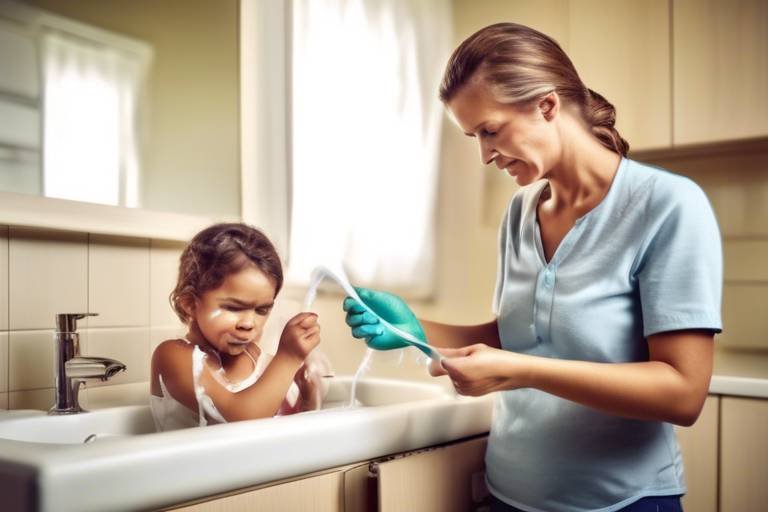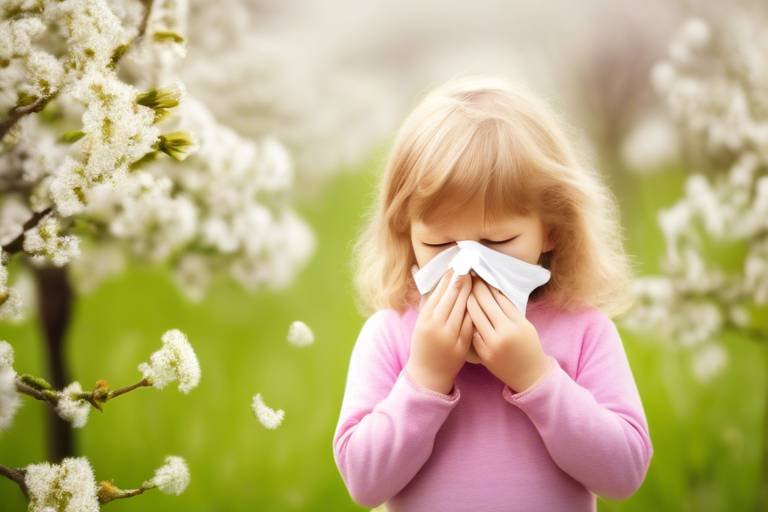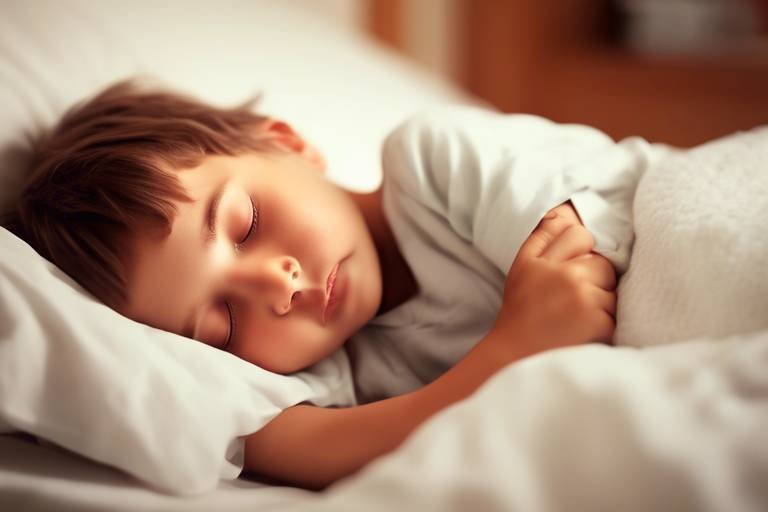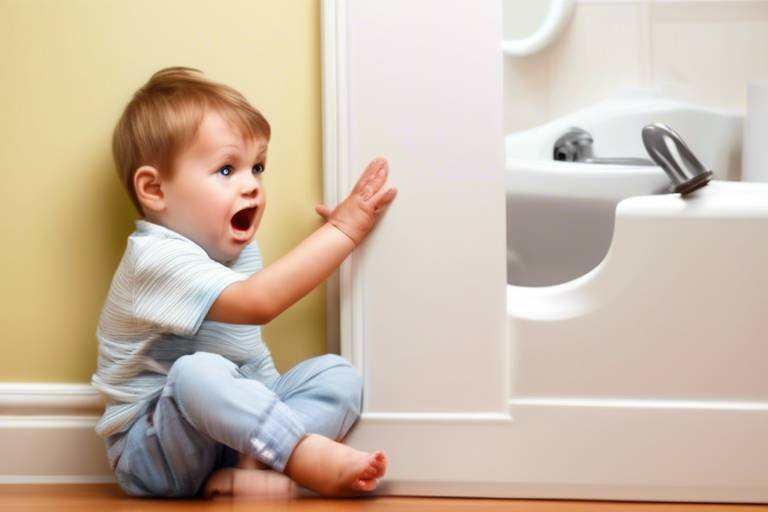Family Hygiene: Ensuring Safety at Home
In today's fast-paced world, the significance of family hygiene cannot be overstated. It's not just about keeping things tidy; it's about creating a safe haven for your loved ones. Think of your home as a fortress against germs and illnesses, where every family member plays a role in maintaining its strength. When we talk about family hygiene, we're diving into a myriad of practices that help prevent illness and promote overall health. The truth is, understanding the importance of hygiene can be the key to unlocking a healthier lifestyle for your entire family.
Imagine this: every time you wash your hands, you're not just removing dirt; you're also washing away the invisible enemies that threaten your family's health. From the moment you step into your home after a long day, the choices you make regarding cleanliness can have a ripple effect on everyone around you. By adopting better hygiene habits, you're not just protecting yourself; you're safeguarding your entire family. It's a collective effort that fosters a culture of health and well-being.
So, why should we care about family hygiene? The answer is simple: it impacts our health. Poor hygiene can lead to the spread of infections, allergies, and other health issues that can disrupt the harmony of your household. By prioritizing cleanliness, you're not only enhancing your family's quality of life but also instilling values that will benefit them for years to come. From young children to elderly family members, everyone can contribute to a cleaner, safer environment.
Moreover, maintaining a hygienic home doesn't have to be a daunting task. With practical tips and a little bit of effort, you can create a routine that ensures your living space remains a sanctuary. In the following sections, we will explore various aspects of family hygiene, including the importance of handwashing, safe food handling practices, and effective strategies for teaching children about hygiene. Get ready to transform your home into a bastion of health!
Family hygiene encompasses practices that prevent illness and promote health. Understanding its significance helps families adopt better habits for overall well-being and disease prevention. When we think about hygiene, we often picture handwashing or cleaning surfaces, but it goes much deeper than that. It includes everything from how we handle food to the ways we teach our children about cleanliness. The goal is to create a safe environment where everyone can thrive.
In essence, family hygiene is about creating a culture of cleanliness that is embraced by every member of the household. It’s about making hygiene a priority in daily life, ensuring that everyone understands their role in maintaining a healthy home. This culture starts with open conversations about hygiene practices, sharing knowledge, and, most importantly, leading by example. When children see their parents practicing good hygiene, they are more likely to adopt those habits themselves.
One of the simplest yet most effective ways to maintain family hygiene is through regular handwashing. It’s a practice that can dramatically reduce the spread of germs and illnesses. Think about all the surfaces we touch every day—door handles, light switches, and even our smartphones. Each of these can harbor harmful bacteria and viruses. By washing our hands frequently and correctly, we can protect ourselves and our loved ones from potential health threats.
Learning the correct method of handwashing can significantly reduce infections. To ensure thorough cleaning, follow these steps:
- Wet your hands with clean, running water (warm or cold).
- Apply soap and lather well, making sure to cover all surfaces of your hands.
- Scrub your hands for at least 20 seconds. Don’t forget the backs of your hands, between your fingers, and under your nails!
- Rinse your hands well under clean, running water.
- Dry your hands using a clean towel or air dry them.
By mastering these techniques, you can significantly cut down on the number of germs that make their way into your home.
When it comes to hand hygiene, you might wonder whether to use soap or hand sanitizer. While both can be effective, they serve different purposes. Soap and water are your best bet when your hands are visibly dirty or greasy. On the other hand, hand sanitizer is a great alternative when soap and water aren’t available, but it should contain at least 60% alcohol to be effective. Understanding when to use each can greatly enhance your family’s hygiene routine.
Identifying key moments for handwashing is crucial. Here are some important times to wash your hands:
- Before preparing or eating food
- After using the restroom
- After coughing, sneezing, or blowing your nose
- Before and after caring for someone who is sick
- After touching animals or handling pet food
Reinforcing these moments in daily routines helps make handwashing a habit for everyone in the family.
A clean home environment is essential for family health. Regular cleaning routines, such as dusting, vacuuming, and sanitizing surfaces, can significantly reduce allergens and germs. Consider creating a cleaning schedule that involves every family member, making it a fun and collaborative effort. This not only keeps your home clean but also teaches responsibility and teamwork.
Proper food handling is vital to prevent foodborne illnesses. By adopting safe practices in food preparation, storage, and cooking, you can protect your family from harmful bacteria that can cause serious health issues.
Understanding hygiene during food preparation can prevent contamination. Always wash your hands before handling food, and ensure that all utensils and surfaces are clean. Using separate cutting boards for raw meat and vegetables can also minimize the risk of cross-contamination. Remember, a little vigilance in the kitchen can go a long way in keeping your family healthy.
Safe food storage practices are crucial for maintaining freshness and preventing spoilage. Make sure your refrigerator is set to 40°F (4°C) or below, and regularly check expiration dates. Organizing your pantry and fridge can also help you keep track of what you have and avoid waste. By being mindful of how you store food, you can ensure that your family enjoys safe and healthy meals every day.
Instilling good hygiene habits in children is essential for their health. Kids are naturally curious, and they often mimic the behaviors of adults. This makes it crucial to provide them with the right tools and knowledge to develop lifelong hygiene habits.
Engaging children in hygiene practices can be challenging, but it doesn’t have to be boring! Incorporate games, songs, and fun challenges to make learning about hygiene enjoyable. For instance, you could turn handwashing into a dance party or create a colorful chart that tracks their hygiene habits. The goal is to make hygiene feel like an exciting adventure rather than a chore.
Children learn by observing adults. If they see you practicing good hygiene, they are more likely to follow suit. Make it a point to demonstrate proper handwashing, cleaning routines, and safe food handling in front of them. By setting a good example, you’re not just teaching them about hygiene; you’re also reinforcing the importance of health and responsibility.
Q: Why is family hygiene important?
A: Family hygiene is crucial for preventing illness and promoting overall health. It helps create a safe environment for everyone.
Q: How often should we wash our hands?
A: Hands should be washed frequently, especially before meals, after using the restroom, and after touching potentially contaminated surfaces.
Q: What are the best practices for food safety?
A: Always wash your hands before handling food, use separate cutting boards for raw meat and vegetables, and store food at the correct temperatures.
Q: How can I teach my children about hygiene?
A: Make hygiene fun through games and songs. Set a good example by practicing good hygiene yourself, and involve them in daily routines.

Understanding Family Hygiene
This article explores the importance of family hygiene, its impact on health, and practical tips to maintain cleanliness at home for a safe and healthy environment.
Family hygiene encompasses a range of practices aimed at preventing illness and promoting health within the household. It's not just about keeping things tidy; it's about creating an environment where family members can thrive without the constant threat of germs and diseases lurking around every corner. When we think of hygiene, we often picture scrubbing floors or washing dishes, but it goes much deeper than that. It involves understanding the significance of cleanliness and how it relates to our overall well-being.
In essence, family hygiene is the foundation of a healthy lifestyle. Just like a well-maintained garden flourishes, a family that prioritizes hygiene cultivates health and happiness. By adopting better habits, families can significantly reduce the risk of infections and illnesses. For instance, did you know that simple actions like regular handwashing and keeping living spaces clean can drastically decrease the likelihood of common illnesses? It’s true! When families embrace hygiene, they not only protect themselves but also contribute to the broader community's health.
Moreover, understanding family hygiene means recognizing the various aspects that contribute to a clean and safe home. This includes:
- Regular cleaning of surfaces that are frequently touched, like doorknobs and light switches.
- Proper waste disposal to prevent the attraction of pests.
- Maintaining personal hygiene practices, which can include everything from showering to oral care.
By instilling these practices as part of daily routines, families can create a culture of cleanliness that benefits everyone. It's about making hygiene a shared responsibility, where each member understands their role in keeping the household safe. In the long run, this not only fosters a healthier living environment but also teaches valuable lessons about responsibility and care for one another.
Furthermore, in an age where we are constantly bombarded with information about health risks, it's essential to stay informed about the best practices for maintaining hygiene. This knowledge empowers families to take proactive steps in safeguarding their health. From understanding the importance of handwashing to recognizing the need for safe food handling, each piece of information contributes to a larger picture of wellness.
As we dive deeper into the specifics of family hygiene, we will explore areas like handwashing, food safety, and creating a clean living space. These topics are not just about following rules; they are about creating habits that will last a lifetime. So, let’s embark on this journey to discover how we can ensure our homes are not just places we live in, but sanctuaries of health and happiness.
- What is the most important aspect of family hygiene?
While all aspects are important, regular handwashing is often considered the most crucial step in preventing the spread of germs. - How can I teach my kids about hygiene?
Make it fun! Use games, songs, and stories to engage them in learning about hygiene practices. - How often should we clean our home?
It’s best to establish a cleaning schedule that includes daily, weekly, and monthly tasks to ensure thorough cleanliness.

Importance of Handwashing
Handwashing is not just a mundane task; it's a powerful tool in our arsenal against germs and infections. Think about it: our hands come into contact with countless surfaces throughout the day, picking up bacteria, viruses, and other pathogens. By regularly washing our hands, we can significantly reduce the chances of getting sick and spreading illness to others. In fact, studies show that effective handwashing can reduce the risk of respiratory infections by up to 21% and gastrointestinal illnesses by 31%. That's a staggering impact from a simple act!
But why is handwashing so effective? The answer lies in the mechanics of how germs operate. Many infectious agents can survive on surfaces for hours, even days. When we touch our face, mouth, or food without washing our hands, we inadvertently introduce these pathogens into our bodies. This is where the importance of handwashing becomes crystal clear. It acts as a barrier, preventing these invisible threats from causing harm.
Now, you might be wondering, "When should I wash my hands?" It's a great question! Here are some key moments that warrant a good scrub:
- Before and after preparing food
- Before eating
- After using the restroom
- After coughing, sneezing, or blowing your nose
- After handling pets or their waste
Incorporating handwashing into your daily routine doesn't have to be a chore. In fact, it can be quite fun, especially for children! Making it a family event, singing a catchy song while washing, or using colorful soaps can turn a mundane task into a delightful experience.
Moreover, understanding the proper handwashing techniques is essential. Just splashing water on your hands won’t cut it! You need to use soap and scrub for at least 20 seconds, ensuring that you cover all surfaces, including between your fingers and under your nails. This thorough approach is what makes handwashing so effective.
In summary, handwashing is a simple yet profoundly effective practice that can protect you and your loved ones from illness. By making it a habit and teaching its importance to children, we can foster a healthier, safer environment at home. So, the next time you reach for that soap, remember: you’re not just cleaning your hands; you’re safeguarding your family’s health!
Q: How long should I wash my hands?
A: You should wash your hands for at least 20 seconds. A good way to time it is to sing "Happy Birthday" twice.
Q: Can hand sanitizer replace handwashing?
A: Hand sanitizer is effective when soap and water are not available, but it’s not a complete substitute. Soap and water are more effective at removing certain types of germs and dirt.
Q: What type of soap should I use?
A: Any soap is effective, but antibacterial soap is not necessary for most situations. Regular soap works just as well for removing germs.
Q: Should children use hand sanitizer?
A: Yes, children can use hand sanitizer, but it should contain at least 60% alcohol. Always supervise young children to ensure they use it safely.

Proper Handwashing Techniques
Handwashing is more than just a routine; it's a **powerful weapon** against germs and illnesses. To truly harness its potential, you need to master the proper techniques. Imagine your hands as a battlefield, where you are the warrior fighting against invisible enemies. By following these steps, you can ensure that your hands are as clean as possible:
- Wet your hands: Start by turning on the tap and wetting your hands thoroughly with clean, running water—warm or cold.
- Apply soap: Use enough soap to cover all surfaces of your hands. Liquid soap is often preferred, but bar soap works just as well.
- Scrub your hands: Rub your hands together vigorously for at least 20 seconds. Don’t forget to scrub between your fingers, under your nails, and the backs of your hands. Think of it as a mini workout for your hands!
- Rinse thoroughly: Rinse your hands well under clean, running water. Make sure all the soap is washed away, as leftover soap can irritate your skin.
- Dry your hands: Use a clean towel or air dry your hands. If you’re in a public restroom, using a paper towel to turn off the faucet is a smart move to avoid recontaminating your hands.
When you wash your hands correctly, you significantly reduce the number of germs on your skin. It’s like putting up a shield that protects you and your family from illnesses. Remember, singing the "Happy Birthday" song twice is a fun way to keep track of the 20 seconds while washing!
In addition to the basic steps, it's essential to understand the importance of using soap versus hand sanitizer. While hand sanitizer is a great alternative when soap and water aren’t available, it’s not a substitute for proper handwashing. Soap works by breaking down the oils and dirt on your hands, effectively removing germs, while hand sanitizer can only reduce the number of germs. Therefore, it's best to reserve hand sanitizer for situations where washing hands isn't feasible, such as when you're on the go.
In conclusion, mastering proper handwashing techniques is a **simple yet effective** way to safeguard your family's health. By making it a habit, you not only protect yourself but also contribute to a healthier community. So, the next time you wash your hands, remember you’re not just cleaning; you’re **empowering** yourself and your loved ones against germs!
Q: How often should I wash my hands?
A: You should wash your hands regularly, especially before meals, after using the restroom, and after being in public places.
Q: Is hand sanitizer as effective as soap?
A: Hand sanitizer is effective when soap and water are unavailable, but washing with soap and water is generally more effective at removing certain types of germs.
Q: What should I do if I don't have soap?
A: If soap is not available, use hand sanitizer that contains at least 60% alcohol. However, always try to wash with soap and water when possible.

Using Soap vs. Hand Sanitizer
When it comes to keeping our hands clean and free of germs, the debate between soap and hand sanitizer is a hot topic. Both options have their merits, but understanding their differences can help you make informed choices for your family's hygiene. Soap and water are the gold standard for hand hygiene, especially when hands are visibly dirty or greasy. This is because soap works by breaking down the oils and dirt on our skin, allowing them to be rinsed away effectively. On the other hand, hand sanitizer is a convenient alternative when soap and water aren't readily available, but it’s important to choose one that contains at least 60% alcohol for maximum efficacy.
While hand sanitizers can reduce the number of germs, they may not eliminate all types of germs, particularly certain viruses and bacteria that are resistant to alcohol. Therefore, it’s essential to know when to use each option. For instance, after using the restroom, handling raw food, or caring for someone who is ill, washing hands with soap and water is always the best practice. However, if you're on the go, a quick squirt of hand sanitizer can be a lifesaver.
Here’s a quick comparison to help clarify:
| Feature | Soap and Water | Hand Sanitizer |
|---|---|---|
| Efficacy | Highly effective against all types of germs | Effective against many germs, but not all |
| Usage | Best for visible dirt and after certain activities | Good for quick disinfection on the go |
| Skin Irritation | Generally gentle on skin | Can cause dryness or irritation with frequent use |
In summary, while both soap and hand sanitizer play crucial roles in maintaining hand hygiene, they are best used in different situations. Understanding when to use each can help ensure that your family stays healthy and germ-free. So, next time you reach for the sanitizer, remember that nothing beats a good wash with soap and water when you can! Keep your family safe by making informed choices about hygiene practices.
Here are some common questions regarding hand hygiene:
- Can hand sanitizer replace handwashing? - No, hand sanitizer should not completely replace handwashing, especially when hands are visibly dirty.
- How long should I wash my hands? - Aim for at least 20 seconds, singing a song can help time it!
- Is homemade hand sanitizer effective? - It can be, but it must contain the right concentration of alcohol to be effective.

When to Wash Hands
Washing your hands might seem like a simple task, but it's one of the most effective ways to prevent the spread of germs and keep your family healthy. So, when exactly should you wash your hands? There are several key moments throughout the day where handwashing is not just recommended, but essential. Think of it as a shield against invisible enemies lurking on your hands!
First and foremost, always wash your hands before meals. Imagine you’ve just come home from a busy day, touched various surfaces, and now you’re about to dive into a delicious meal. If you skip washing your hands, you might as well be inviting those germs to dinner! Similarly, after using the restroom, it’s crucial to wash your hands. Not only does this practice prevent the spread of bacteria, but it also sets a good example for your kids.
Here’s a quick rundown of other important times to wash your hands:
- After coughing, sneezing, or blowing your nose.
- Before and after caring for someone who is ill.
- Before and after handling food, especially raw meat.
- After touching pets or animals.
- After handling garbage or cleaning products.
By incorporating these moments into your daily routine, you ensure that everyone in your household is practicing good hygiene. It’s like building a fortress around your family's health. And remember, the more consistent you are with handwashing, the more it becomes a habit, especially for the little ones who are watching your every move.
In addition to these key moments, it’s also important to educate your children about why handwashing is necessary. Turn it into a fun activity! You could sing a silly song while washing or create a handwashing chart to track their progress. Making it enjoyable will encourage them to take hygiene seriously, and before you know it, they’ll be washing their hands without you even having to remind them!

Maintaining Clean Living Spaces
Keeping our living spaces clean is not just about aesthetics; it’s about creating a healthy environment for our families. A clean home reduces the risk of allergies, infections, and other health issues. Imagine walking into a home that smells fresh and feels inviting—this is the kind of atmosphere we want to cultivate for our loved ones. So, how do we achieve this? Let’s dive into some practical tips that can transform our living spaces into clean sanctuaries.
First and foremost, regular cleaning routines are essential. Establishing a daily, weekly, and monthly cleaning schedule can help ensure that every corner of your home receives attention. For instance, daily tasks might include wiping down kitchen counters and sweeping floors, while weekly chores could involve vacuuming carpets and mopping hard surfaces. Monthly deep cleaning can tackle areas like the refrigerator and behind furniture. By breaking down these tasks, cleaning becomes less overwhelming and more manageable.
Another crucial aspect is decluttering. It’s amazing how much cleaner a space feels when it’s free of unnecessary items. Take a moment to look around your living room or kitchen. Are there items that no longer serve a purpose? Consider donating or recycling them. Not only does this create more space, but it also makes cleaning easier since there are fewer items to move around. Additionally, organizing your belongings into designated places can help maintain order and cleanliness. Use baskets, bins, or shelves to keep similar items together—this way, everything has a home, and it’s easier to keep things tidy.
Let’s not forget about the importance of ventilation. A well-ventilated home helps reduce moisture and prevents mold growth, which can be detrimental to health. Open windows whenever possible to let fresh air circulate, and consider using exhaust fans in areas like the kitchen and bathroom where humidity tends to build up. Plants can also contribute to cleaner air by filtering out toxins, so consider adding some greenery to your living spaces.
Lastly, don’t underestimate the power of routine maintenance. Regularly checking and replacing air filters, cleaning carpets, and washing curtains can significantly improve indoor air quality. When it comes to cleaning products, opt for eco-friendly options that are less harsh on both your family and the environment. Not only are they safer, but they also contribute to a more pleasant living space without the overwhelming scent of chemicals.
By implementing these strategies, maintaining clean living spaces becomes a breeze. It’s all about creating habits that promote cleanliness and health, ensuring that our homes are safe havens for our families. Remember, a clean home is a happy home!
- How often should I clean my home? Aim for daily quick clean-ups, weekly deep cleaning, and monthly maintenance tasks.
- What are some eco-friendly cleaning products? Look for brands that use natural ingredients, or try DIY solutions like vinegar and baking soda.
- How can I involve my children in cleaning? Make it a game or set up a reward system to encourage them to help out.
- What are the best ways to declutter? Start small, tackle one room at a time, and use the "one in, one out" rule for new items.

Safe Food Handling Practices
When it comes to keeping your family safe and healthy, are absolutely essential. Foodborne illnesses can wreak havoc on your household, leading to discomfort, missed days at work or school, and even serious health complications. So, how can you ensure that every bite you take is safe? It all starts with understanding the basics of food safety, which includes everything from preparation to storage. By adopting simple yet effective practices, you can significantly reduce the risk of contamination and illness.
First and foremost, let's talk about food preparation hygiene. Before you even think about chopping vegetables or marinating meat, it's crucial to wash your hands thoroughly with soap and water. This simple action can eliminate harmful bacteria that may have been transferred from your hands to the food. But handwashing is just the tip of the iceberg. You should also clean all surfaces and utensils that will come into contact with food. Think of your kitchen as a battlefield; if you want to win against germs, you need to arm yourself with a clean and sanitized environment.
Next, consider the importance of separating raw and cooked foods. Cross-contamination is a common culprit behind foodborne illnesses, and it can occur when raw meat juices come into contact with ready-to-eat foods. To avoid this, use separate cutting boards for raw meats and vegetables. This not only helps in keeping your meals safe but also makes your cooking experience more organized. Remember, a little bit of planning can go a long way in maintaining food safety.
Now, let’s dive into storing food safely. Proper food storage is just as important as preparation. Make sure to refrigerate perishable items promptly, ideally within two hours of cooking or purchasing. Use airtight containers to keep your food fresh and to prevent any unwanted odors from mingling. Also, be mindful of your refrigerator’s temperature; it should be set below 40°F (4°C) to inhibit bacterial growth. To make it easier, you can keep a thermometer in your fridge to ensure it’s always at the right temperature.
Another crucial aspect to consider is the cooking temperature. Use a food thermometer to ensure that your meals reach the appropriate internal temperature. For instance, ground meats should be cooked to at least 160°F (71°C), while poultry needs to reach 165°F (74°C). Not only does this help kill harmful bacteria, but it also ensures that your food is deliciously cooked and safe to eat. Ignoring these temperatures can be like playing a game of Russian roulette with your health.
In conclusion, practicing safe food handling is a vital step towards maintaining your family’s health. By focusing on proper hygiene during food preparation, separating raw and cooked foods, storing items correctly, and ensuring that everything is cooked to the right temperature, you can create a safer dining experience for everyone. Remember, it’s all about making informed choices and adopting habits that protect your loved ones from harmful germs.
Q: What are the key steps to safe food handling?
A: The key steps include washing hands and surfaces often, separating raw and cooked foods, cooking to the right temperatures, and refrigerating perishable items promptly.
Q: How can I tell if my food is stored safely?
A: Ensure your refrigerator is set below 40°F (4°C), use airtight containers, and check for any signs of spoilage before consuming.
Q: Is it necessary to use a food thermometer?
A: Yes, using a food thermometer is crucial to ensure that your food has reached a safe internal temperature, killing harmful bacteria effectively.
Q: How can I make food safety fun for my kids?
A: Involve them in the cooking process by teaching them about hygiene and safety while preparing meals together. You can turn it into a game by challenging them to remember the rules!

Food Preparation Hygiene
When it comes to ensuring the safety of our meals, is a cornerstone that cannot be overlooked. Imagine your kitchen as a battleground where germs and bacteria lurk, waiting for the perfect opportunity to invade your food. By adopting good hygiene practices during food preparation, you can create a fortress that protects your family from foodborne illnesses. So, what exactly does food preparation hygiene entail? It's all about keeping your cooking environment clean, your ingredients safe, and your hands sanitized.
First and foremost, cleanliness is key. Before you even think about chopping vegetables or marinating meat, give your hands a thorough wash. This is not just about running them under water; you need to scrub with soap for at least 20 seconds, making sure to get between your fingers and under your nails. It's a small step that can make a world of difference. After all, your hands are the primary tools you use when preparing food, and they can easily transfer harmful bacteria if not properly cleaned.
Next, let's talk about surfaces. Your countertops, cutting boards, and utensils should be treated like a blank canvas—clean and ready for action. Use hot, soapy water to wash all surfaces before and after food preparation. For extra protection, especially when dealing with raw meat, consider using a disinfectant spray or wipes to eliminate any lingering bacteria. It's like giving your kitchen a refreshing shower, ensuring that everything is spotless and ready for the culinary magic to unfold.
Now, you might be wondering about the ingredients themselves. It's essential to keep raw and cooked foods separate to avoid cross-contamination. Picture this: you’ve just chopped some raw chicken on your cutting board and then use the same board to slice fresh vegetables for a salad. Yikes! That’s a recipe for disaster. To prevent this, use separate cutting boards—one for raw meats and another for fruits and vegetables. If you don’t have multiple boards, make sure to wash and sanitize the board thoroughly between uses.
Additionally, always pay attention to the temperature of your food. Bacteria thrive in the “danger zone,” which is between 40°F and 140°F (4°C and 60°C). To keep your food safe, ensure that perishables are stored in the refrigerator at or below 40°F and that hot foods are kept above 140°F. This simple temperature control can prevent harmful bacteria from multiplying, keeping your meals safe and delicious.
In summary, food preparation hygiene is about creating a safe environment for cooking and eating. By washing your hands, keeping surfaces clean, separating raw and cooked foods, and controlling temperatures, you can significantly reduce the risk of foodborne illnesses. Remember, a little diligence goes a long way in keeping your family healthy and happy!
- What are the most common foodborne illnesses? Common foodborne illnesses include Salmonella, E. coli, and Listeria. These can cause severe symptoms and should be taken seriously.
- How often should I wash my hands while cooking? You should wash your hands before starting to cook, after handling raw meat, and after touching any surface that may harbor bacteria.
- Can I use the same cutting board for raw meat and vegetables? It's best to use separate cutting boards to avoid cross-contamination. If you must use the same board, ensure it is thoroughly cleaned and sanitized between uses.
- What temperature should my refrigerator be set at? Your refrigerator should be set at or below 40°F (4°C) to keep food safe from bacterial growth.

Storing Food Safely
When it comes to maintaining a healthy household, safe food storage is a cornerstone that often gets overlooked. Think of your refrigerator and pantry as the frontline soldiers in the battle against foodborne illnesses. Proper food storage practices not only keep your food fresh but also help in preventing spoilage and contamination. Imagine biting into a piece of fruit that looks perfect on the outside, only to discover it's spoiled on the inside. That’s a disappointment no one wants to face!
To ensure that your food stays safe and delicious, it's crucial to understand how to store different types of food. For instance, perishable items like meat, dairy, and certain fruits and vegetables should be kept in the refrigerator at temperatures below 40°F (4°C). This temperature slows down the growth of bacteria, making it a safe haven for your groceries. On the other hand, dry goods like pasta, rice, and canned foods can be stored in a cool, dry pantry. Here’s a little tip: always check the expiration dates on these items regularly. Just because something is in the back of the pantry doesn't mean it's still good!
Another important aspect of safe food storage is organization. Keeping your refrigerator and pantry organized not only makes it easier to find what you need but also helps prevent cross-contamination. For example, raw meats should always be stored on the bottom shelf of the refrigerator to avoid dripping onto other foods. You can use clear containers to separate different food items, which also helps in monitoring what you have on hand. This can save you from the dreaded "what's for dinner?" dilemma!
Here’s a quick reference table to help you remember safe storage practices for various food types:
| Food Type | Storage Temperature | Storage Duration |
|---|---|---|
| Meat (raw) | Below 40°F (4°C) | 1-2 days in fridge; 6-12 months in freezer |
| Dairy Products | Below 40°F (4°C) | 1 week after opening |
| Fruits & Vegetables | Below 40°F (4°C) | Varies; check freshness |
| Canned Goods | Cool, dry place | 1-5 years (check expiration) |
Lastly, always remember the golden rule: when in doubt, throw it out. If you're unsure about the safety of a food item, it's better to be safe than sorry. Your health and the health of your family are worth more than a few dollars saved on groceries. By following these simple yet effective food storage practices, you can ensure that your kitchen remains a safe and healthy environment for everyone.
Q: How can I tell if food has gone bad?
A: Look for changes in color, texture, or smell. If something seems off, it’s best to discard it.
Q: Is it safe to eat leftovers after a week?
A: Generally, leftovers should be consumed within 3-4 days if stored properly in the refrigerator.
Q: Can I refreeze food that has been thawed?
A: Yes, but only if it was thawed in the refrigerator. Food thawed in water or the microwave should be cooked before refreezing.
Q: What’s the best way to store herbs?
A: Fresh herbs can be stored in the refrigerator wrapped in a damp paper towel or placed upright in a glass of water like a bouquet.

Teaching Hygiene to Children
Teaching hygiene to children is not just about instilling good habits; it's about empowering them with the knowledge and skills they need to stay healthy throughout their lives. As parents or guardians, we often find ourselves in a unique position to shape our children's understanding of hygiene, making it a crucial part of their daily routine. But how do we make these lessons stick? The key is to make hygiene engaging and relatable.
One effective way to teach hygiene is through hands-on activities. For instance, you could turn handwashing into a fun game. Create a catchy song that they can sing while washing their hands, ensuring they scrub for at least 20 seconds. You might say, "If we can make it fun, they’ll remember it!" This approach not only reinforces the importance of cleanliness but also helps them associate hygiene with positive experiences.
Another important aspect is to explain the “why” behind hygiene practices. Children are naturally curious, and answering their questions can help them understand the significance of what they're doing. For example, when teaching them about brushing their teeth, you could explain how plaque can lead to cavities, using simple terms they can grasp. This understanding makes them more likely to adopt these habits willingly.
Moreover, children learn a lot by observing adults. This is where the concept of modeling behavior comes into play. If they see you washing your hands regularly, wearing a mask when sick, or keeping your living space tidy, they are likely to mimic those actions. It's a powerful reminder that our actions speak louder than words. So, let’s be the role models they need!
To make the learning process even more effective, consider incorporating visual aids. Charts, colorful posters, or even storybooks that emphasize hygiene can capture their attention and reinforce the lessons you’re teaching. For example, a chart showing the steps of handwashing with fun illustrations can serve as a daily reminder for them to follow. You can even create a rewards system where they earn stickers for practicing good hygiene, turning it into a fun challenge!
Lastly, don’t forget to celebrate their achievements. When they remember to wash their hands before meals or brush their teeth without being reminded, give them a high-five or a small reward. Positive reinforcement goes a long way in encouraging good habits. Remember, the goal is not just to teach them hygiene but to help them embrace it as a vital part of their lives.
Q: At what age should I start teaching my child about hygiene?
A: You can start teaching hygiene habits as early as toddler age. Simple practices like handwashing and brushing teeth can be introduced early on.
Q: How can I make hygiene practices more engaging for my child?
A: Use songs, games, and visual aids to make hygiene fun. Incorporating rewards for good hygiene practices can also motivate them.
Q: What are some common hygiene practices I should teach my child?
A: Essential practices include handwashing, brushing teeth, bathing regularly, and keeping their living spaces tidy.
Q: How can I encourage my child to wash their hands regularly?
A: Explain the importance of handwashing, make it fun with songs, and set reminders or visual cues around the house.

Making Hygiene Fun
Getting kids excited about hygiene can often feel like trying to get a cat into a bathtub—challenging and messy! But don’t worry, it’s not impossible. The key is to make hygiene practices engaging and enjoyable. Think of it as turning a mundane task into a fun game. For instance, you could create a handwashing song that lasts for 20 seconds—the recommended time for effective handwashing. This way, kids can sing along while they scrub away those pesky germs. You might be surprised at how quickly they pick up the habit when it feels like play!
Another approach is to use colorful visual aids. Consider putting up a chart in the bathroom that shows the steps of proper handwashing or tooth brushing. You can even include fun stickers or stamps that they can earn for completing hygiene tasks. This not only makes the process interactive but also gives them a sense of achievement. Who doesn’t love a shiny sticker for a job well done?
Additionally, incorporating storytelling can be a powerful tool. Create a character, like “Captain Clean,” who goes on adventures fighting germs and saving the day with the power of hygiene. You can read stories about Captain Clean and his heroic deeds, and then relate those adventures back to the importance of washing hands or brushing teeth. This not only captivates their imagination but also reinforces the message that hygiene is a superhero skill!
Lastly, consider organizing fun hygiene-themed activities. For example, you could host a “Hygiene Day” where kids can participate in games like “Germ Tag,” where one person is ‘it’ and has to tag others while holding a soap bar (the ‘germ’). This way, they learn about the importance of cleanliness while enjoying themselves. Remember, the goal is to create positive associations with hygiene practices so that they become second nature as your children grow. After all, when hygiene feels like fun, kids are more likely to embrace it for a lifetime!
- Why is hygiene important for children? Hygiene is crucial for children as it helps prevent illness, promotes overall health, and instills lifelong habits that contribute to their well-being.
- How can I encourage my child to wash their hands regularly? You can encourage handwashing by making it fun—singing songs, using colorful soaps, and creating a reward system can motivate them to wash their hands more often.
- What are some fun hygiene activities for kids? Activities like creating hygiene-themed crafts, playing games that emphasize cleanliness, or even hosting a hygiene-themed party can be enjoyable ways to teach kids about hygiene.
- How often should children brush their teeth? Children should brush their teeth at least twice a day—once in the morning and once before bed—to maintain good oral hygiene.

Setting a Good Example
When it comes to teaching children about hygiene, one of the most powerful tools we have is our own behavior. Children are like little sponges, soaking up everything they see and hear from the adults around them. This means that if we want them to develop good hygiene habits, we must first model those behaviors ourselves. Think about it: if a child sees their parent skipping handwashing after using the restroom, they might think it's okay to do the same. On the flip side, when they observe their parents diligently washing their hands, they are more likely to adopt that practice as part of their routine.
To effectively set a good example, it’s essential to incorporate hygiene into daily life seamlessly. Here are a few strategies to consider:
- Be Consistent: Consistency is key. Make sure to practice good hygiene habits regularly, so children understand that these actions are not just occasional but a part of everyday life.
- Explain the Why: Children are naturally curious. When you perform hygiene tasks, take a moment to explain why they’re important. For example, you might say, “I’m washing my hands to get rid of germs that can make us sick.” This helps them understand the significance behind the actions.
- Involve Them: Get your children involved in hygiene practices. When you’re cleaning the house, invite them to help. When they see you cleaning surfaces or washing dishes, they learn that hygiene is a shared responsibility.
Moreover, creating a routine can help reinforce these habits. For instance, you might establish a morning routine where everyone brushes their teeth, washes their face, and washes their hands before breakfast. This not only makes hygiene a natural part of their day but also turns it into a bonding experience. Consider using a fun chart to track their hygiene habits. You could reward them with stickers or small incentives for completing their hygiene tasks consistently, making it a fun and engaging activity.
Remember, the goal is to create an environment where good hygiene is valued and practiced. When children see their parents prioritizing cleanliness, they are more likely to internalize these values and carry them into adulthood. It’s like planting seeds that will grow into lifelong habits. So, let’s lead by example and make hygiene a family affair!
Q1: Why is it important to set a good hygiene example for children?
A1: Setting a good example is crucial because children learn by observing adults. When they see you practicing good hygiene, they are more likely to adopt those behaviors themselves, leading to healthier habits.
Q2: How can I make hygiene more appealing to my children?
A2: You can make hygiene fun by incorporating games, songs, or rewards into the routine. For example, you might sing a song while washing hands or create a sticker chart to track their progress.
Q3: What are some common hygiene practices I should model for my kids?
A3: Common hygiene practices include regular handwashing, brushing teeth, bathing, and cleaning up after meals. By demonstrating these actions consistently, you instill good habits in your children.
Frequently Asked Questions
- What is family hygiene and why is it important?
Family hygiene refers to the practices that help prevent illness and promote overall health within a household. It’s essential because maintaining good hygiene reduces the spread of germs and diseases, ensuring a safer environment for everyone, especially children and the elderly.
- How often should we wash our hands?
Hands should be washed frequently throughout the day, especially before meals, after using the restroom, and after coming home from public places. Regular handwashing is one of the simplest yet most effective ways to prevent the spread of germs.
- What are the proper handwashing techniques?
To wash your hands properly, wet them with clean, running water, apply soap, and lather for at least 20 seconds. Make sure to scrub all parts of your hands, including the backs, between your fingers, and under your nails. Rinse well and dry with a clean towel.
- Is hand sanitizer as effective as soap and water?
While hand sanitizer can be effective in killing germs, it’s not a substitute for soap and water. Soap and water are more effective at removing certain types of germs and dirt, especially when hands are visibly dirty or greasy.
- How can I maintain a clean living space?
To keep your home clean, establish a regular cleaning schedule. Focus on high-touch surfaces like doorknobs, light switches, and countertops. Use disinfectants, declutter regularly, and encourage everyone in the household to contribute to maintaining cleanliness.
- What are safe food handling practices?
Safe food handling includes washing hands before and after handling food, using separate cutting boards for raw meat and vegetables, cooking food to the right temperatures, and storing food properly to prevent spoilage.
- How can I teach my children about hygiene?
Teaching children about hygiene can be fun! Use games, stories, and songs to make learning engaging. Also, involve them in daily routines, like handwashing before meals, to reinforce these habits in a playful way.
- Why is it important to set a good example for children?
Children often mimic the behaviors of adults. By practicing good hygiene yourself, you set a positive example that encourages them to adopt similar habits. This modeling is crucial for instilling lifelong hygiene practices.



















